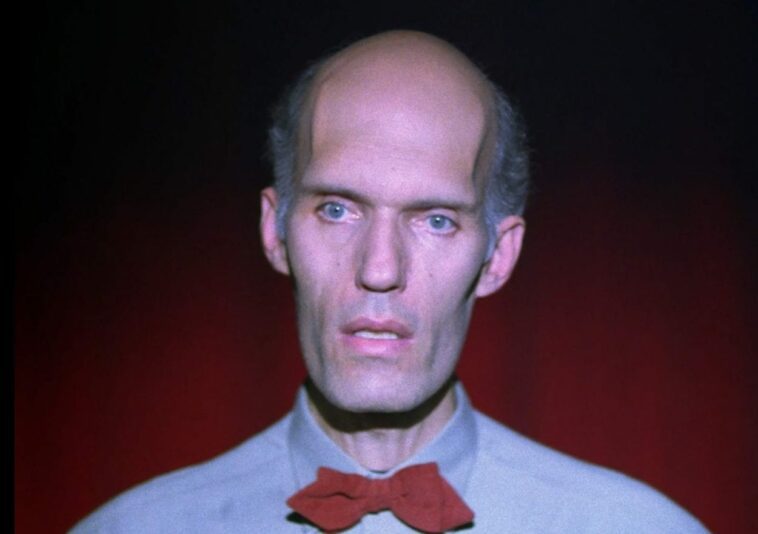On Sept. 30, 1990, just over four months after the first season concluded, Twin Peaks returned with Episode 8, the opening episode of Season 2, another 90-minute edition directed by David Lynch and scripted by Mark Frost, and yet it was clear right from the start that the cozy surrealism of that initial run had been infected with a strain of darkness, much like the insects that fester beneath the grass in Blue Velvet. We were not in Kansas anymore, Toto—there’s a giant here.
There had been clues, of course. The publication of The Secret Diary of Laura Palmer by David’s daughter, Jennifer Lynch, on Sept. 15, made it painfully, challengingly, and bravely clear that for all the quirkiness and coffee and doughnuts and fish in percolators, there was real abuse and real trauma at the core of the show. The book was unflinching in its portrayal of Laura, and while its dark, pained tone might have seemed at odds with the nature of that first season, in time it would be clear that the diary had enriched and deepened this world we had fallen in love with, as would Fire Walk With Me and The Return.
The Season 2 premiere was a further step forward in the process of darkening and enriching the world of Twin Peaks. But it would not be the pain and trauma of The Secret Diary that it would reflect but rather the esoteric and occult preoccupations of its co-creator, Mark Frost. If the first season brought us the characters and the sense of time and place, Season 2 really brought in the elements that would be crucial to the development of the show’s mythology.
This was certainly deliberate, at least on Mark Frost’s part:
I wanted to inject a level and layer of metaphysical material and David was all for it. That planted the show’s roots a little deeper in the ground and that was part of what we were presenting: life is not just a series of events that happen to you, it’s also on another level a mythological experience, during which you are constantly receiving messages from or making contact with your subconscious. […] I think it gave it a deeper sense of mystery beyond the obvious. [1]
In this article, I want to focus on how the Season 2 premiere focused on introducing the show’s key mythology, how this led to a darker tone, yet kept the warmth that was at the core of the show. I’ll also be arguing for how I believe that elements of the episode’s opening scenes can be looked at in a new light when viewed through the lens of The Return.
So, come with me, but beware: the owls are not what they seem…
A New Kind of TV
This change in tone or intent is evident right from the start of the premiere, quite literally. As the opening credits come to a close, with the focus on the strangely reddened sun-dappled water, it dissolves into darker, murkier waters running in slow motion beneath crooked, ominous branches before we cut to the Great Northern at night, enshrouded in mist accompanied by an ominous soundscape. And if you hadn’t gotten the message from that, you soon would.
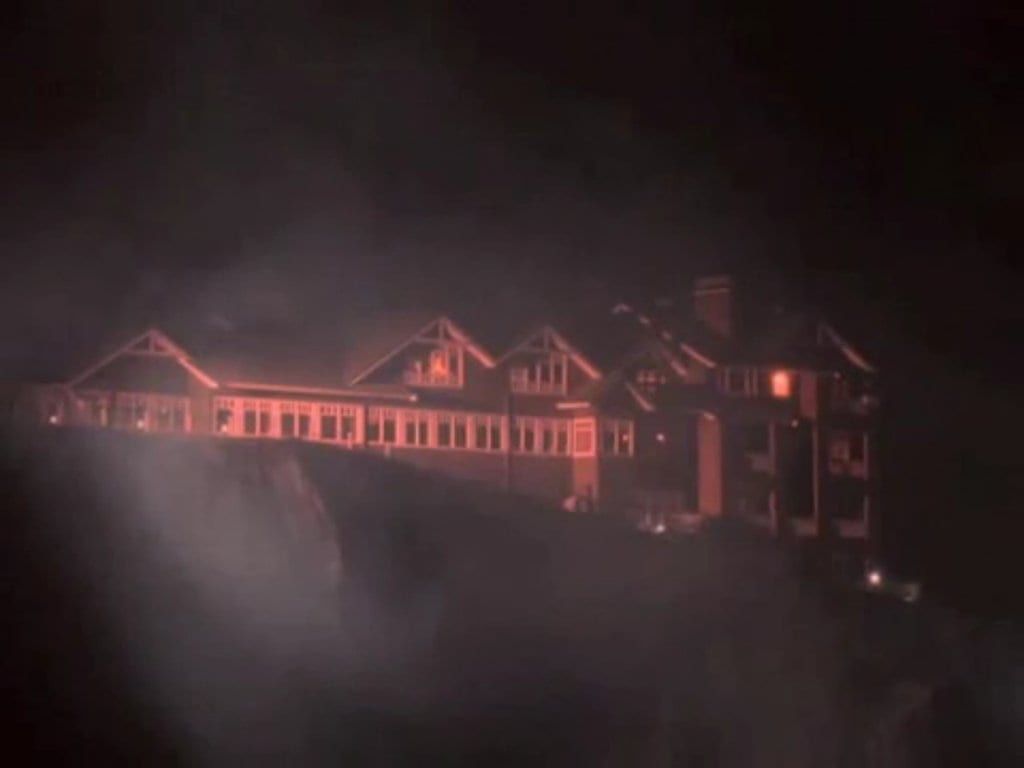
Episode 8 picks up right where the previous season’s cliffhanger ending left off: with Dale Cooper lying on the floor of his room in The Great Northern, severely wounded from the gunshot he had received from his then-mystery assailant. It suggests an awareness of the need to immediately hook the viewer back in after the break, but don’t let this immediacy of storytelling fool you—Lynch was about to take viewers down a different rabbit hole.
This opening scene was perhaps one of the most contentious in the original series’ history at that point. It’s been argued that this scene put off many viewers who had come along for the ride with Season 1 but felt this was a step too far, plus new viewers who wanted to see what all the hype was about. Even Craig Miller referred to this episode as a “mediocre two-hour first episode” [2] in the first issue of Wrapped in Plastic—something he and John Thorne confirmed they had changed their mind about in Issue 68—but I’d be pretty confident he would’ve had this scene in mind.
It’s easy to forget in the “golden era” of TV that it was not easy to be artistically expressive and individualistic with the medium without some resistance, at the least, from both TV networks and audiences alike. TV was meant to fast-paced, edited with a punchy rhythm, and feature a mini-cliffhanger of sorts on the threshold of each break to keep fans from switching channels and also to keep them watching those lucrative advertisements in between. TV shows were not meant to confront the viewer or make them feel uncomfortable, nor challenge them with art and surrealism. They were meant to be metaphorical comfort food for the advertising industry.
It’s not talked about often, but where the first season of Twin Peaks was really radical was in character, place, and mood, but not necessarily in form. Yes, there were trips to The Red Room via dreams, but that was more to do with story and place. Formally, the show, whether as a pastiche or otherwise, followed a nighttime soap opera format. Season 2 would arguably be less knowing in its use of the genre, but the first season would utilize the elements of the form it was supposedly pastiching: relatively quick cuts between scenes and constant action and dialogue. The show presented a dream, but to paraphrase Lynch, the first season didn’t give you room to dream. The form was still recognizable as the standard TV setup of the time. It’s not irrelevant, I think, that Lynch was away for a large chunk of the first season filming Wild at Heart.
Twin Peaks Welcomes Slow, Intuitive Drivers
With the opening scene of Season 2, the gloves were off. Although we begin where we left off, with the downed Cooper, the ensuing opening scene lasts 7 minutes and 46 seconds and continues after a break created by Audrey and Ben Horne’s scene at One-Eyed Jacks for a further 3 minutes and 20 seconds, meaning that a total of 11 minutes and 6 seconds of the first part of the episode is spent with the immobile Cooper on the floor of his room in the Great Northern.
Now, 11 minutes and 6 seconds is nothing really, in the grand scheme of things, and certainly is nothing out of the ordinary with the opening up of how TV can tell stories over the last two decades. In 1990, however, this would have been highly unusual and possibly monotonous. Not only that, but Lynch was working to his own concept of time, which involves movement and pace being true to what the story and imagery require from them. To the general TV audience of the time, perhaps not connoisseurs of Lynch’s filmography, the pace must have seemed glacial.
Wrapped in Plastic described this opening sequence as being on “first viewing and interminably slow” and “measured and slow-paced (even by 1990 standards)” [3], while also acknowledging the scene is a “perfectly-paced comedy piece—not the sort of things viewers were expecting” [4]. Indeed, there’s a touch of Samuel Beckett to this opening scene—the sense of almost standing outside of time, the nonsensical humor and dialogue. The exchanges between the old waiter and Cooper, with their focus on the failure of language to truly communicate (Cooper and the waiter only really come to an understanding through the physical gesture of a thumbs-up) and the emphasis on skewed priorities (checking for a gratuity over demanding an ambulance) are pure absurdist theatre, much like the exchanges between Audrey and Charlie are in The Return years later.

Did Lynch think that this slowing of pace outside the standard TV format of the time and the prioritization of absurdist humor was what the scene truly needed to work, or was there a sense that he was sending a message to ABC? “I will not fit into your narrow, limiting format anymore. I demand room to dream.” I can imagine the two feelings were intertwined. Lynch has spoken previously about how the pull of television for him is the ability it provides to tell a continuing story, but the restrictions and demands of television networks made it difficult to achieve the freedom to do this in a way that allowed him to be completely true to the story itself. The Season 2 premiere’s opening scene acted as a statement of intent, Lynch following his creative intuition.
It is interesting to note that although there was major anticipation for the new season, Wrapped in Plastic states that “the first half-hour managed to come fourth in its timeslot” [5]. Part of that will be the surrealism of what the viewer was confronted with. Another part could well be that the new, curious viewer was not given an entry point or an easy access point to get into the show and quickly catch up with what had gone before.
Partway through the episode, Cooper and Albert brief Truman and company on the investigation of Laura Palmer’s murder, and the scene functions as a perfect kind of refresher for the regular audience and a concise, accessible explanation for the new viewer. It seems strange, then, that this scene would be placed over an hour into the episode. Granted, it couldn’t have come much earlier because Coop was immobile on the floor to start, but if you were tuning in out of nowhere back in 1990 and were introduced to the show with Coop and the Giant, you’d be forgiven for whatever confusion you might have experienced.
It seems, then, that not everybody was keen to follow David Lynch’s intuition.
Giants, Fireman, Cooper, and Free Will
What follows with the Giant will begin to shape Twin Peaks mythology in a major way, and yet what is most interesting about the scene now is viewing it in light of what we know thanks to The Return. Obviously, it is hard to make concrete links between the two in light of the at times wilful discrepancies in continuity between the original series and The Return. The intentions of 1990 will not necessarily be the intentions of 2012, when Frost and Lynch sat down to write the new series.
And yet the more present work cannot help but influence the past, as Cooper does by virtue of his intervention in the past with Laura in The Return, and the newer show pulls the Season 2 premiere into all sorts of curious shapes.
For example, the waiter hanging up the phone on Andy doesn’t seem helpful. In fact, it seems to obstruct Cooper getting the help he so desperately needs. It brings to mind the ambiguity of The Giant’s statement in the Season 2 finale with The Man From Another Place: “one and the same”. Did the Giant have the foresight to know that Cooper will not die and that if Andy and Truman show up early, he will not be able to impart his wisdom to Coop? This in turn begs the question: How much of what happens to the characters is pre-determined, i.e. is fatalistic? How much can the Giant prevent, or does he simply shape? If he does have foresight, can he see his own actions? If so, does he have to obey said questions or does the Giant have free will?
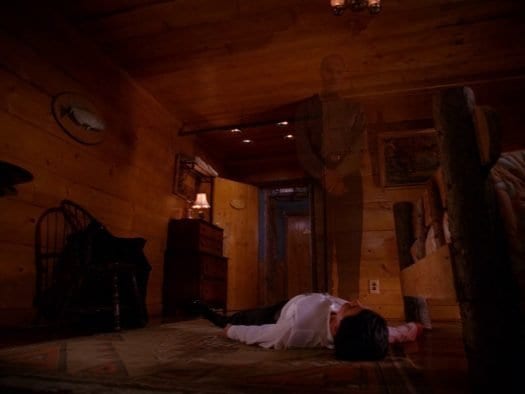
It’s a fascinating question. Assuming that the Giant and the Fireman are the same character and not simply identical but different people, we can then fairly assume that the Fireman does have foresight, of a kind. He tells Cooper in the opening to The Return that he needs to remember “430, two birds with one stone, Richard and Linda.” Does he tell Cooper this because he knows Cooper will say it, thereby creating some kind of ouroboros-type circle throughout time?
There are further interesting details here that we can link to The Return. In light of all the speculation regarding the question “Who is the dreamer?” and at what point Cooper really leaves the Red Room, it is fascinating that the Giant answers the question “Where do you come from?” by asking, “The question is: Where have you gone?” Cooper’s amazement later in the episode that the Giant took his ring suggests that while Cooper assumed his visitation from the Giant was a dream, it actually occurred in waking life. But what if Coop’s first instinct was correct? What if Cooper was meeting with the Giant in a dream? What if Cooper was really viewing all this from The Red Room, a place he entered upon being shot? If one was to argue that Cooper is the dreamer, this scene could be pivotal to the idea. No, I don’t personally believe all of Season 2 is Cooper’s dream, but I love the idea on its own terms. It would also offer a neat explanation for the darkness that seems to infuse the show over the season.
Cosmic Alterations via The Return
The scene also raises curious questions about the Giant’s origin and purpose. When revealing the three clues that Cooper needs to look out for (including the major Peaks mythological detail, “The owls are not what they seem”), the Giant reveals, “This is all I’m permitted to say.” But permitted by who? Why? For what reason? Is there an order above and beyond the Giant? We can assume from The Return that the Fireman/Giant has some kind of omniscience or at least some kind of position of power in the cosmic realm. He is able to view the nuclear events on Earth and their consequences and can intervene by sending the Laura orb to Earth (note the golden orb he sends to Cooper at the end of this episode) to provide balance. He is also able to provide Freddie with his green glove and provide Andy with the knowledge he will need to save the day.
And yet, is the Giant himself instructed by a higher power or force? Or is it even necessarily another entity? He could indeed be governed by some kind of cosmic laws that we do not have access to and are unable to understand, a kind of Lovecraftian cosmic horror that drives us mere mortals to madness (and arguably Cooper, too).
It is also intriguing that the Giant implies a kind of doubt on Cooper’s part, as if they had met before and Cooper had not believed in him. “I will tell you three things,” the Giant intones. “If I tell them to you, and they come true, then will you believe me?” For those who take it that Coop is stuck in an eternal circle, repeating his mistakes quite literally over and over in some kind of bardo state, this line becomes extremely enticing. It also suggests a willingness for the host to let cosmic entities in before they can truly be helped. That’s not to say the Giant possesses Cooper, but one wonders if Leland had to welcome BOB in, and Sarah Palmer had to let her darkness inhabit her. The question is further emphasized by the Giant’s statement to Cooper, “We want to help you.” Who’s we? The Giant’s governing bodies, as it were? The offer of help is clear, but Cooper must be willing.
True to Lynch’s belief in the fallibility of language to truly communicate, Cooper and the Giant have to use physical gestures and coded messages to express and gauge said willingness to be initiated into the cosmic horror. For example, when the waiter says to Cooper “The Milk will get cool on you pretty soon,” it could be an example of Lynch’s off-kilter humor and this emphasis on the fallibility of language, but within that, it could be seen as a coded message. Is the Giant, via the waiter, trying to inform Cooper via a metaphor that he hasn’t got much time left? And not just in regard to the fact that he’s been shot but, as we will see, BOB will strike again via Leland and will claim another victim, Laura’s cousin Maddie. Or it could even be that the Giant knows that Cooper hasn’t got long before he has to show perfect courage in The Red Room? Is the Giant warning Coop that he needs to get serious now because he hasn’t much time to prepare?
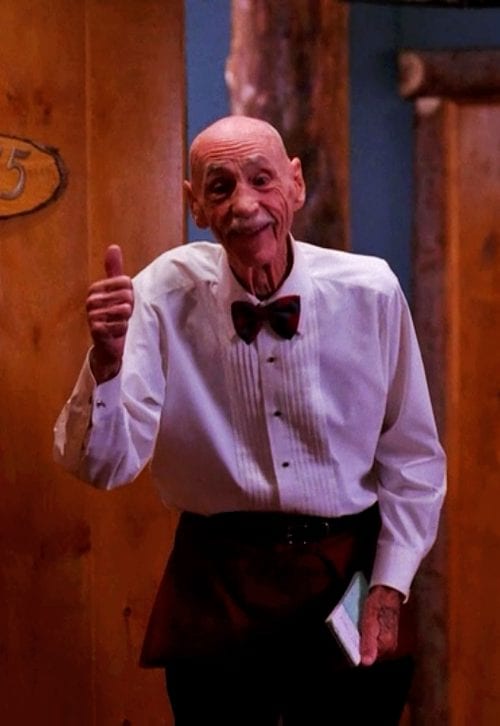
There is also a curious moment when the waiter and Cooper exchange thumbs-up. It initially appears to emphasize the idea that the waiter is an oblivious shell for the knowledgeable Giant, but I believe that there is a kind of coded exchange here, perhaps subconsciously on Cooper’s part, but one which shows some kind of confirmation of understanding given to the Giant and an invitation for him to come in.
It starts with the waiter giving a thumbs-up and winking at Cooper, with no response. The waiter then comes back and gives the thumbs-up again and says “I heard about you,” to which Coop responds with a thumbs-up of his own. Not apparently satisfied with that, as if he wants more of a concrete confirmation of understanding, the Waiter comes back a third time and gives another thumbs-up, to which Coop responds by pointing weakly as if he’s too hurt to complete the gesture, or perhaps in recognition on a subconscious level of who the waiter really is—at this point, the waiter becomes the Giant. Did Coop invite the giant in, so to speak? Were these physical gestures really a kind of code?
At the very least, the taking of Cooper’s ring by the Giant can definitely be understood as having a significant communicatory element. Once Cooper finds that the things the Giant has told him are true, he will have the ring returned to him. If it’s true that you have to give something of yourself in exchange for true theosophical learning, then is the ring a deposit on learning secret knowledge? Will he get it back once he has obtained the knowledge needed to buy his way into a deeper realm of understanding? He does get it back by the end of the episode, but he still has a lot to learn about the world of the Giant and BOB, as we will see throughout Season 2. But it does prove that true change can’t be given; it needs to be earned.
The Darkness Spreads Like a Virus
With that initial scene signposting a new tone and depth to the show, the darkness this new esoteric mythology adds to the show’s world quickly spreads to the rest of the show like a virus—good for the viewer, not so for the inhabitants of Twin Peaks.
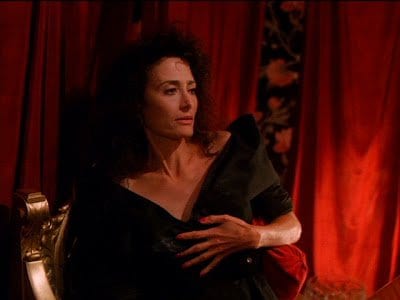
Whereas Blackie was nothing less than confident in the first season, here she is weak and desperate. She is revealed to be a drug addict, something not alluded to in Season 1, and she’s anxious to the point of despair for a fix. It’s Jerry she speaks to, and he also surprises by showing an aggressive side that was not present in the bumbling idiot of the first season, his face creased with fury when he suddenly shouts “WHAT’S THAT, BLACKIE?” He’s also knowingly cruel when he shines the light on Blackie’s face and says, “You used to be so pretty.” The change is so sudden, as if Coop’s shooting has just extinguished the light in the town. You could say the same about the show’s clock reaching 25 years later by The Return: many people, both fans and critics of the new show, commented on how the twinkle had all but disappeared from the show’s eye.
There’s a good reason for the darkness choosing to infest One-Eyed Jacks. Following Jerry’s verbal assaults, we are forced to view a particularly uncomfortable, narrowly avoided physical assault. The scene featuring the unknowing Ben chasing around the masked Audrey is uncomfortable anyway because a father lusts (albeit unknowingly) after his daughter, while the daughter is terrified of the unbridled, unveiled desires of the father. But it is precisely this father/daughter relationship that adds extra frisson from a narrative point of view; a foreshadowing of Leland’s abuse of Laura.
After a mythology-heavy start, this is where the season begins to prove that The Secret Diary of Laura Palmer was not just a cheap piece of tie-in merchandise or a one-off aberration away from the quirky world of the show. Rather, it doubles down on the idea that for all the wonderful and fascinating mythological and theological elements, at heart the show is still about a girl who was sexually abused and then killed by her own father. Sure, viewers didn’t know this at the time. Then again, we’ve only just been indoctrinated properly with this episode and the subsequent season into the world of giants, owls, Lodges, and dwellers on the threshold. Twin Peaks’ soul is still up for grabs. All will be revealed—quicker than wanted due to the impatience of ABC and the television audience—but they will not be given an easy ride.
I Wish You Nothing but the Very Best in All Things
But it was not all doom and gloom. There were shards of light still to be found in the mythology, and one of the most important character developments occurs in this episode. Major Briggs had been a compelling but rather stiff character in Season 1. Here, the show begins to peel back the layers, highlighting his qualities of supreme intuition, foresight, and empathy for the esoteric, as well as hinting at the classified, secretive nature of his work, aspects that would become important throughout the rest of the season, as well in The Secret History of Twin Peaks and The Return. Not only that, but it also helped to usher in the warm, loving Major that the fandom quickly clutched to their hearts and have held there ever since.
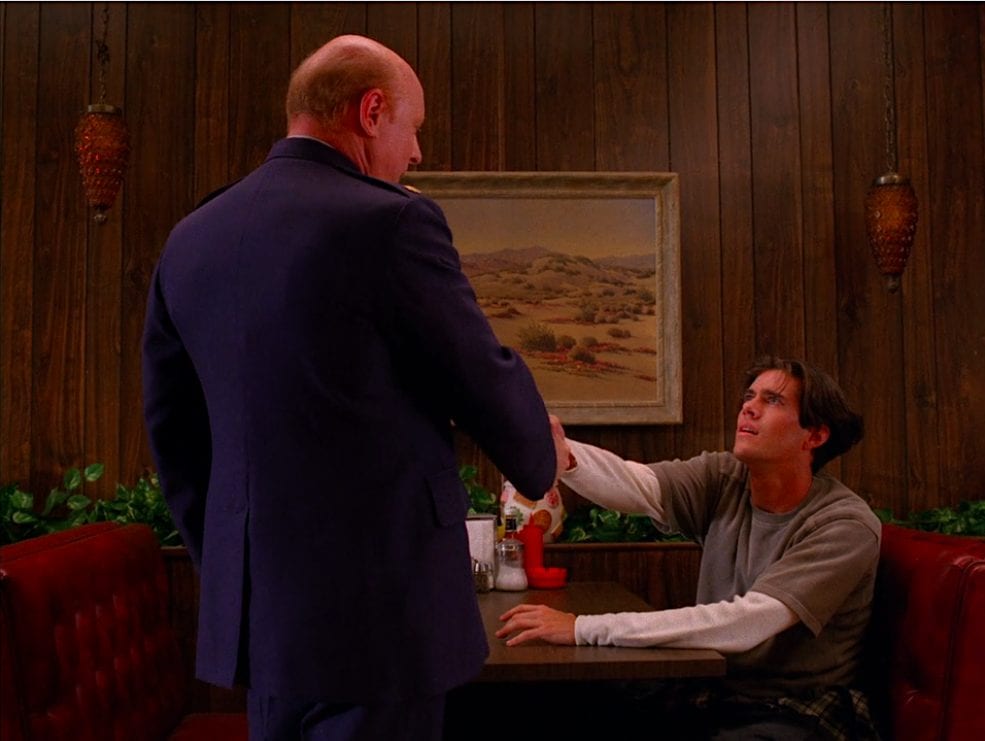
More than anything, it starts what will become the redemption of Bobby Briggs. The clear love with which Major Briggs speaks of his son here not only pulls at Bobby’s heartstrings but ours:
My son was standing there. It wasn’t you, but in a way it was. He was happy and carefree, clearly living a life of deep harmony and joy. We embraced, a warm and loving embrace, nothing withheld. We were, in this moment, one. My vision ended and I awoke with an overwhelming feeling of optimism and confidence about you and your future. That was my vision of you. […] I wish you nothing but the very best in all things.
Up to this point, Bobby Briggs has been a truculent juvenile delinquent with a bad attitude, parental conflicts, and a taste for the “naughty salt.” He sounds for all the word like a Bret Easton Ellis character. This powerfully emotional conversation will trigger Bobby to begin to better himself, working with Ben Horne (although admittedly, he tries to blackmail his way in) and eventually becoming an officer in the Twin Peaks Sheriff’s Department.
The Bobby that cries at Laura’s photo in The Return begins here and proves that, even in the darkness and the gloaming, love can still blossom and flourish…
Light in the Darkness
“May the Giant Be With You” is an extraordinary episode, especially when watched in hindsight. This episode really begins to bring the darkness to the surface, infusing and enriching the world of Twin Peaks with those initial moments of theology that will be expanded upon as Season 2 continues. The Return has further transformed the way we see this episode’s events, enriching it further still and giving us another lens through which to theorize about the original series.
But unlike The Return (which I genuinely love, don’t get me wrong), the warmth of the show remains here to offer us hope that we can counterbalance the dark. Major Briggs and Bobby show us the way in this episode with a dialogue full of compassion and genuine love and understanding, an idea which will reach real fruition by the end of the season when Cooper offers up his soul to save Annie.
May The Giant (and the Major) be with us all.
[1] Frost, Mark, Quoted by Dukes, Brad. Reflections: An Oral History of Twin Peaks. Nashville Short/Tall Press, 2014.
[2] Miller, Craig and Thorne, John. “Twin Peaks Second Season Episode Guide (Part 1)”. Wrapped in Plastic, Vol.1 #68, Dec. 2003, pp. 2-19.
[3] Miller, Craig and Thorne, John. “Twin Peaks Second Season Episode Guide (Part 1)”. Wrapped in Plastic, Vol.1 #68, Dec. 2003, pp. 2-19.
[4] Miller, Craig and Thorne, John. “Twin Peaks Second Season Episode Guide (Part 1)”. Wrapped in Plastic, Vol.1 #68, Dec. 2003, pp. 2-19.
[5] Miller, Craig and Thorne, John. “Twin Peaks Second Season Episode Guide (Part 1)”. Wrapped in Plastic, Vol.1 #68, Dec. 2003, pp. 2-19.

